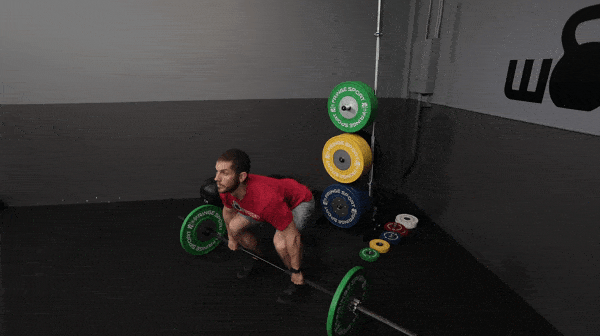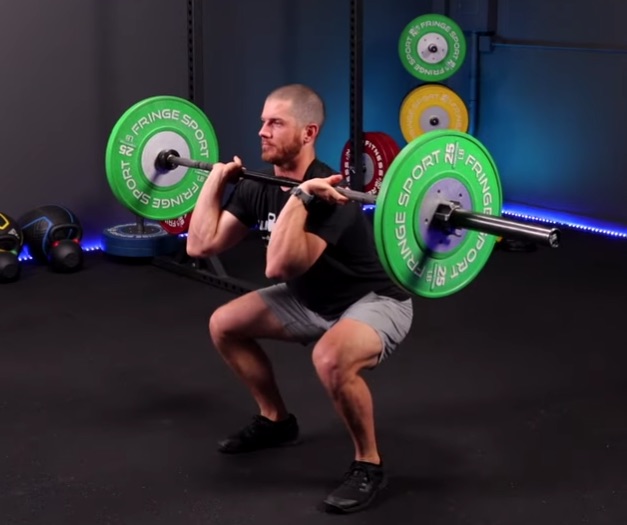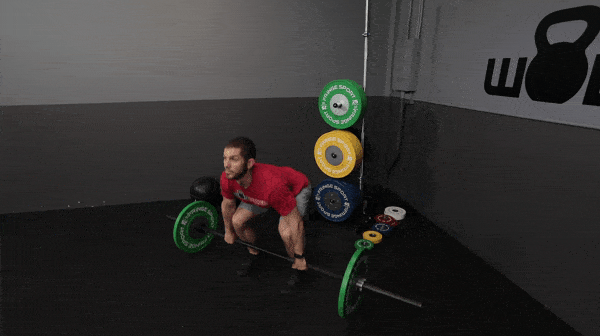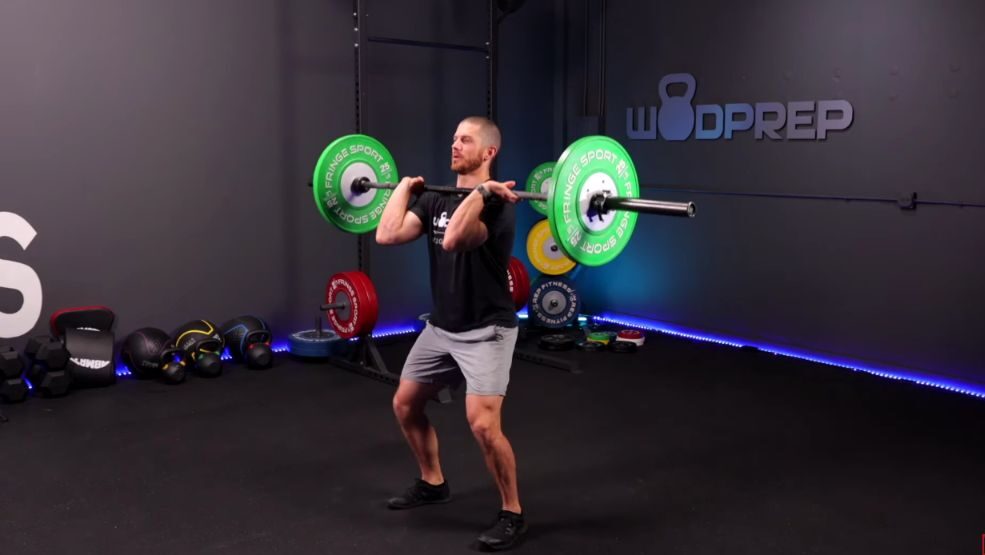Power or Squat? What's the difference, right? And when you're first starting out as a beginner, does it really matter? There's a lot of confusion sometimes about the difference between a power snatch and a squat snatch, and I know weightlifters reading this will be saying absolutely not. But in CrossFit Weightlifting, there are some specific elements that will stop you from progressing, whether you're a beginner or an intermediate.
If you are looking to advance your technique, especially in the snatch, I have a completely free training guide that will give you five drills every Crossfitter must know when it comes to the snatch.
What is a power clean or a power snatch?
To demonstrate, I'll focus on the much simpler movement, the power clean. A power clean is where you catch the weight of the barbell and stand it up while never passing through a squat position. So that means catching the weight above parallel. And then standing up.
Here's what a power clean looks like:

You'll see that I'm catching it clearly above the squat position and then standing in the video. But what many people don't realize is that a power clean can also look like this.

The hip crease is above the top of my knee, and even though it appears to be a very squatty position, it's still technically a power clean. So even if the position is above the hip crease and above the top of my knee, whether it's a clean or a snatch, it's still a power lift because it's caught above parallel.
So don't be confused. For the lift to be a power, you don't have to catch it all the way up at the top for it to count. Most people will let themselves get about this low, and then they stand. They rarely practice receiving the bar in a half squat or three-quarter squat position.
Okay, so what does a squat clean or a squat snatch look like?
As you can imagine, it's either of those movements that catch that receive in or pass through a squat position, by CrossFit standards. A squat is when the hip crease passes below the top of the knee, where we go below parallel.
Here's what it looks like:

You can see them all the way down. And then I've said, technically, this would also count as a squat clean by CrossFit standards.
You can see how I rode the barbell down, and I caught it in the power position, but since I went down into the full squat, that still counts as I passed through the parallel position.
So with that, you should be able to tell whether it's a snatch, clean or squat, snatch or power clean or power snatch.
What if I get no repped?
Good question. You probably will at some point.
It's sometimes really close. For instance, what happens if it's right at parallel?
I don't know if that's a tough call. And you're gonna have to rely on your coaches to judge you. Particularly, if the judge is under pressure to make a call at a competition let's say, remember to check your ego at the door.
You may or may not have had a no rep on some of those questionable teckers, but keeping calm and carrying is key. To avoid this eventuality, practicing proper form with every rep in training is the only way.
If coach asks for power. Stay above parallel.
If coach asks for squat. Remember, it's ass to grass.

Why practice power variations?
Why would we practice power cleans and power snatches in the sport of CrossFit or functional fitness?
1. The power position is a great, easier version.
It's a great scale or progression of the full squat, especially when mobility is still a limiting factor. If we think about it over several touch and go reps in a WOD, it's easier to pick up the barbell, catch it on my shoulders and stand. This is opposed to doing the same thing, but right down in the full squat position.
Why is that easier?
There's less moving parts, and less mobility is required. If, like me, just trying to keep count in the workout is hard enough, then frankly, adding more moving parts and coordination will confuse your brain further.
So for that one reason, we practice the power position, and we often teach it early on in our CrossFit journey of learning these advanced skilled barbell movements.
2. It can be used as a technique to teach stronger pulling.
When performing a power clean or power snatch, you're looking to catch the barbell above the parallel position, which forces you to really focus on pulling the barbell upwards much more.
From the years of coaching, I've typically seen athlete's become lazy by becoming reliant on the squat to catch their lifts. As a result, the athlete starts to develop a nasty habit of not finishing their pull; they don't finish jumping with their legs to put a tonne of power into the floor and thus move as much weight.
Legs are super powerful; in fact, they are one of the most powerful parts of our body, and we want to make the most of them. However, suppose I don't use all the power of my legs, and I just rely on dropping under the barbell into a full squat. This is where you'll see people sacrifice a lot of weight that they could have moved if they had practiced those power positions and really learning to jump that weight up to get the upward momentum on the barbell.
3. You can overtrain the squat position in weightlifting.
In CrossFit, we have numerous leg dominant movements from; pistols, back squats, front squats, burpees, lunges, assault bike, and so on! After a week of training, it's easy to overload and overtrain the muscles. Without proper prevention methods, it's easy to see how athletes may get injured.
Think about it: if every time we just touched the barbell, and we were only practicing the squatting positions, not only would it be a little bit difficult, it would be more challenging to learn. We'd always be fatiguing our quads and legs, thereby hindering potential gains and progress.
In a sport like CrossFit and functional fitness, we're always trying to prepare the body (and muscles) with "constantly varied, high-intensity functional movements". By just practicing the squatting patterns while squatting patterns are phenomenal. And we're going to get to that in a second. Power versions of the lifts can be a great way to prevent squatting and going below parallel to many days per week.
Why practice squatting?
1. The most important reason why we do squat cleans or squat snatches, or in weightlifting terms, snatches and cleans full versions, is because they're stronger.
When looking at your PRs, you'll typically find that your squat cleans and squat snatches are significantly higher.
Why is that?
If you look at the fundamentals of how high you need to lift the bar, you don't need to lift it as high with my pull than if you're squatting underneath it to receive it.
To receive the barbell in a power position, let's say I'm touching at a pretty low power position, I would need to get the barbell close to my chest.
Reversely, if I need to receive it in the squat position, I only need to get the barbell to my waist height. Technically, as you can see, there's a difference between how high I need to move it for the power and how high I need to move for the squat.
Improve Your Coordination
So far, we've broken down a few essential points in the snatch and clean movement, but when looking to progress your skills, nuances in how you move will be more important.
Improving your coordination is one of them. Improving your squatting position isn't enough to take you to the next level.
Spoiler alert, if your power snatch and power clean are stronger than your squat snatch and your squat clean, you need to do some work.
Other than just being stronger, squatting is a great movement to help us practice coordination.
Having the ability to properly time dropping under the bar for a squat snatch and squat clean requires piecing together all the moving pieces, moving parts, more muscle fibers and the coordination of putting that all together is a seamless ensemble.
Improve your Mobility
Improving your mobility rarely gets touched on, or we've collectively decided to ignore the elephant in the room as a community. But unfortunately, if you're looking to progress in the sport, we have to work on areas that aren't necessarily in our wheelhouse.
The squatting pattern trains more muscles, and squatting is probably something you do every single day when you sit on the toilet. So if we don't train the squat, then we're going to lose our ability to squat. Training the squat with a little weight, especially with overhead and weight in the front rack is a great way to maintain full squat mobility.
By training your mobility, you're training your positional strength to carry weight from the top position all the way down to the bottom of that squat position.
Show me someone who can catch a clean at the bottom, or catch a snap snatch at the bottom, control it and stand it up. That's someone who is coordinated and mobile and someone who's going to stay healthy for a very long time.
So with that being said, we've covered the difference between power and squat snatches and cleans, which means the next time you go to the gym, you should easily be able to call out to your buddy and say that was a power clean or that was a squat clean, and obviously, no rep them.
